Is a Space Elevator Possible? Stairway to Heaven Is Coming Soon!
28th Feb 2024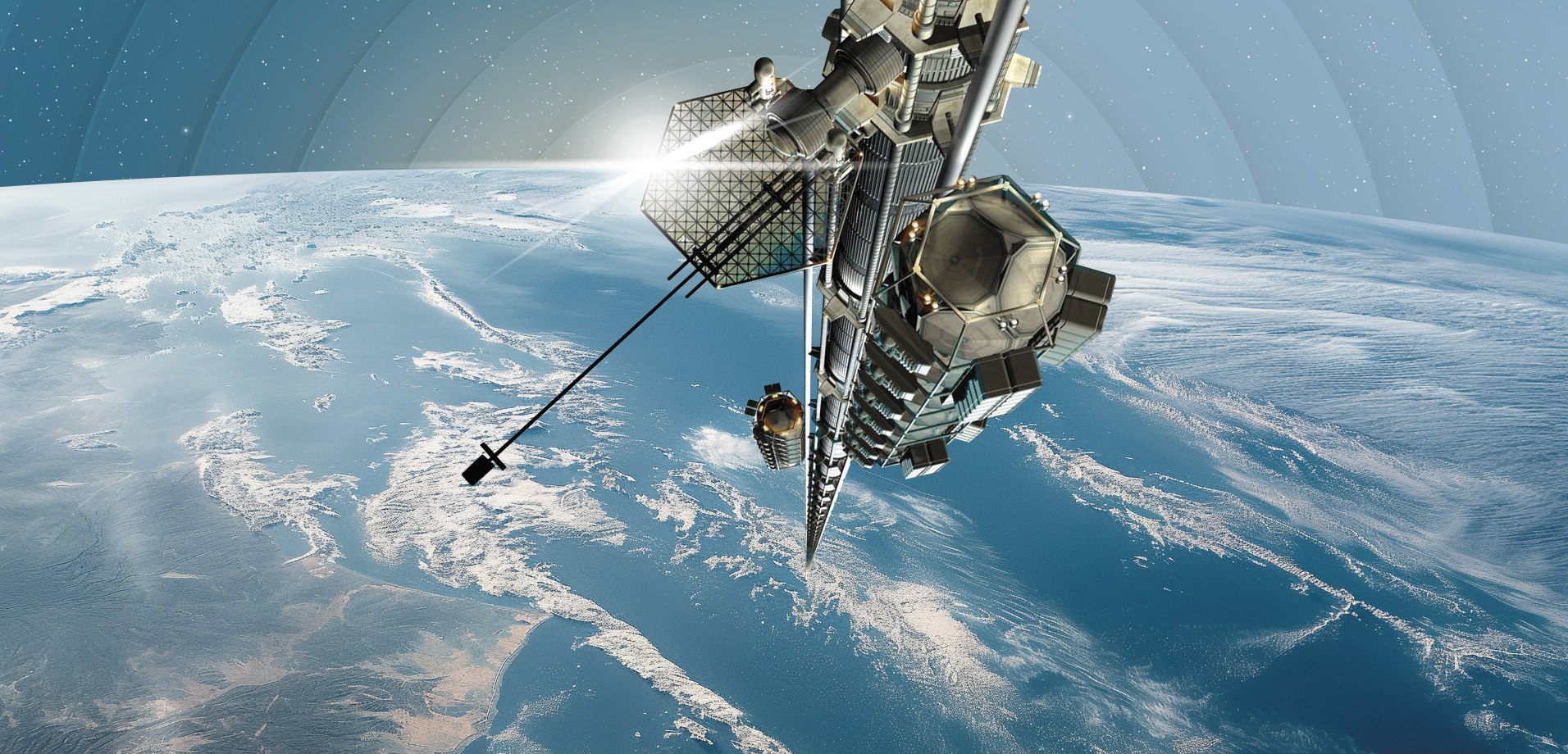
Imagine you no longer need a military pilot’s education or years of gruelling training and tests to enter space. Just press a button, and a special cabin will take you to orbit. A space elevator. What is it? An impossible fantasy or a close reality?
In this article, we will consider the space elevator concept and evaluate the prospects of this unique type of vehicle. Watch out, the doors are closing. Here we go up!
What Is a Space Elevator?
A space elevator or space lift is still a hypothetical structure for lifting cargo and people from the surface of the Earth or another planet into orbit without rockets and spacecraft. Like a conventional terrestrial lift, orbital elevators use a tether stretched from a base on the surface to a counterweight beyond geostationary orbit (35 thousand km). Cabins and containers move along the cable, delivering the payload to the desired height.
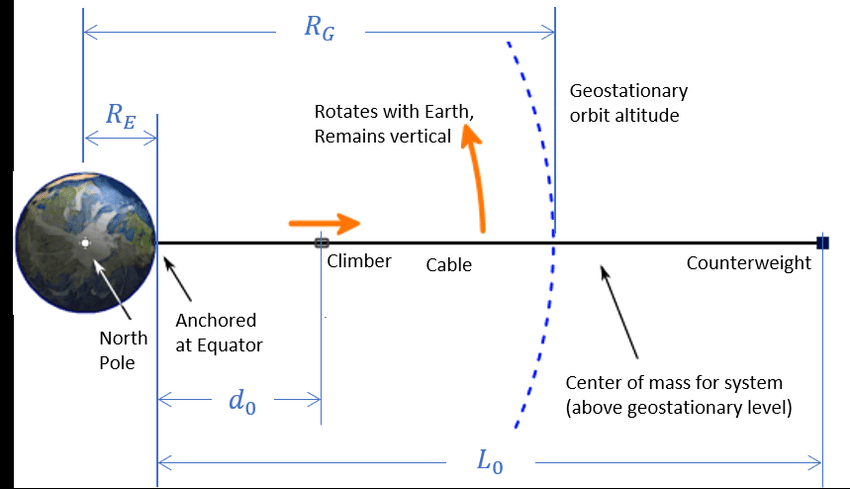
But if everything is clear with a residential elevator, then how would it work in space? Imagine that you picked up a rock on a rope and started swinging it around… the outward force maintains stability, and the rope keeps the rock in place until you let go.
It is believed that the orbital lift could significantly reduce the cost and complexity of space transportation, as well as open up new opportunities for research and exploration. Let’s see if these forecasts are indeed so rosy.
Concept Development Throughout History
The idea of an orbital lift was first proposed by Konstantin Tsiolkovsky in 1895. Inspired by a visit to the Eiffel Tower, the scientist imagined a free-standing tower reaching from Earth to geostationary orbit, which could be ascended with an elevator. However, such a tower was initially impossible due to the enormous pressure and compression the construction would be subjected to.
In 1959, an American engineer, Johannes Ferner, proposed another concept of an elevator to space based on the use of a tether held in tension between the Earth and a counterweight in orbit. Such a tether would not need support from below. It would rely on a balance between gravity and centrifugal force. In 1966, American physicist Jerome Pearson developed a more detailed orbital elevator concept, considering various factors such as load, vibration, safety, and economics.
In 1975, the American writer Arthur C. Clarke published the novel The Fountains of Paradise, where he described space lift as a real engineering structure. This novel caught public attention, stimulating further research and development in this area. In 1979, Soviet scientist Isaac Beitzman proposed a lunar lift to deliver materials from the Moon to Earth, and two years later, American scientist Hans Moravec proposed using the technology to launch probes into deep space.
In 2005, the first Space Elevator Games competition was held, organised by the Spaceward Foundation with the support of NASA. Since then, the competition has been held annually, and its participants demonstrate their achievements in two categories: “best cable” and “best robot (lift)”.
In 2008, the International Space Elevator Consortium (ISEC) was created, bringing together scientists, engineers, writers, and enthusiasts interested in creating an elevator to space.
Space Elevator Designs & Operating Principle
So, as you already understand, the structure consists of four main elements: a base, a cable, a lifter and a counterweight. Now, let’s look at each of them in detail.
Cable
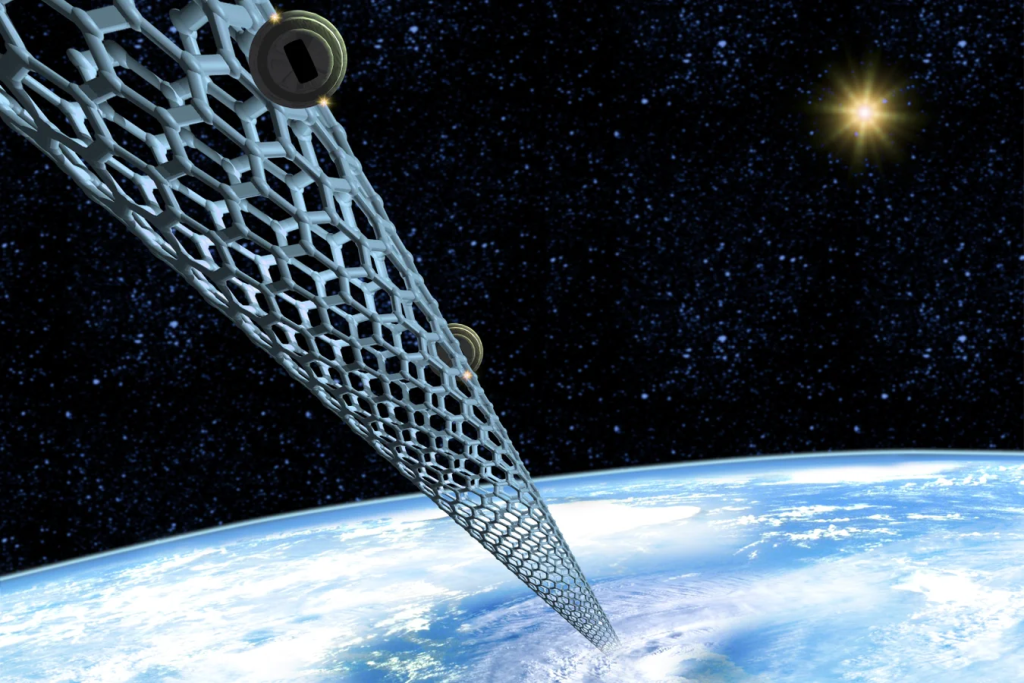
The main element of the structure. Cabins and payload containers move along the cable, so it must be made of a material with an extremely high tensile strength to specific density ratio. This means that the material must be very light and very strong at the same time to withstand enormous loads and stresses, such as atmospheric friction, cosmic debris, solar radiation, lightning, wind, and temperature changes. For this purpose, it can be coated with special protective layers or have systems for detecting and avoiding dangers.
Base
This is the place where the lower end of the cable is secured and where the lifting of the load begins. The base can be stationary or mobile, located on land or water. The advantages of a stationary base are cheaper and more accessible energy sources, resistance to wind and the ability to reduce the cable length. The advantages of a mobile base are the ability to manoeuvre to avoid hurricanes, storms, satellites and cosmic debris.
Lifter
Lifters move along the cable, delivering goods and people to different heights at different speeds. Their types can vary depending on the size, power, throughput, and method of obtaining energy. Here are some possible lifter cabin options:
- Mechs. They use electric or hybrid motors to move along the cable. They can be powered by batteries, generators, solar panels, or wireless power transmission from a base or satellites. Mechanical lifters can be large and fast, but they require complex control and security systems.
- Climbers. They use mechanical grips to cling to the cable and move along it. They can receive energy from lasers aimed at their solar panels or heat engines. These climbers may be small and cheap, but they are also slow and unreliable.
Counterweight
A counterweight is an object attached to the top end of a space lift tether that holds it under tension. Some possible counterweight options include:
- Asteroid. It can be captured and pulled into the orbit of the Earth or another celestial body to use as a counterweight. Due to its mass, an asteroid can be a reliable counterweight for an orbital lift, but it is difficult and expensive to intercept and control.
- A station is an artificial satellite that can be built in space or delivered into orbit. The station may be small and light but functional and useful for scientific and commercial purposes.
- Ring — a ring structure that surrounds and rotates around a cable. The ring may have less mass than other types of counterweights but a larger area and moment of inertia. It can also provide additional stability and protection to the cable.
- The loose end is the part of the tether that does not have any counterweight but simply stretches into space. The loose or free end may have the lowest cost and complexity but also the lowest reliability and safety. It may be subject to rupture, vibration, or impact from other bodies.
Where Is the Best Place to Put a Space Lift?
The base should be located at or close to the equator, as this ensures the least cable deviation from the vertical and the least impact of the Coriolis force. The base should also be located away from major cities, airports, and military installations to avoid potential hazards in the event of a structure collapse or tether failure.
How High Would an Orbital Lift Go?
The counterweight, that is, the upper part of the elevator, must be located above the geostationary orbit (36 thousand km) since this is the only orbit in which the satellite rotates at the same angular speed as the Earth around its axis. This makes it motionless relative to the surface of the Earth. Thus, the cable stretched between the base and the counterweight does not experience friction or tension from the rotation of the Earth, and the lifter can move along it unhindered.
Could a Space Lift Make Space Travel Easier?
Scientists are confident that the structure can simplify the task of cosmic transportation. In what ways?
Cost Reduction
How much does a space elevator cost? According to early calculations by American astrophysicist Bradley C. Edwards, the cost of building and launching the first viable orbital lift design could be about $40 billion and $100 per kilogram to lift the payload into geostationary orbit. For comparison, the cost of one launch of the Falcon 9 rocket at GSO is estimated at $60 million, and the cost of delivering 1 kg of cargo is $2,500.
Environmental Friendliness
Using electricity to lift its payload, the orbital lift is called the “big green machine.” Just imagine. During one launch, the rocket launcher, depending on its class (light, medium, heavy), emits from 200 to 2000 tonnes of toxic fuel into the atmosphere. And there are over a hundred such launches a year. Compared to rockets, space lifts look like a green road to space.
Safety
The technology eliminates the risks associated with failures, explosions, or malfunctions of rockets, which can lead to loss of life and property damage. It will also reduce the amount of cosmic debris that can pose a threat to satellites and spacecraft. The facility will be equipped with safety systems and protocols to prevent accidents and damage.
Increasing Accessibility
The orbital lift technology will make space travel more commonplace and accessible to a wider range of people and purposes, for example, for tourism, research, exploration, colonisation, and exploitation of cosmic resources. Ground bases have lower requirements for accommodation and equipment than spaceports, and people do not need to undergo gruelling pre-flight training.
So far, everything looks very promising, but what about technology implementation?
Is an Elevator to Space Really Possible?
Like any complex and ambitious project, the space lift faces many technical, logistical, and other challenges.
Choosing the Right Materials
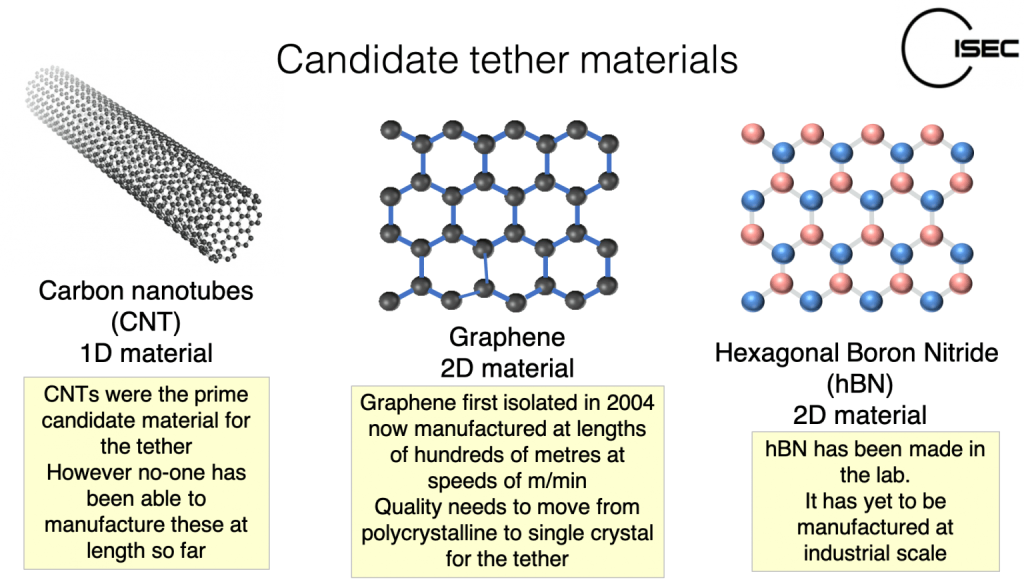
What is the main component of an orbital lift? Of course, the cable. And this is where the main difficulty arises. In 1999, Bradley Edwards, as mentioned before, wrote in his report for NASA that all the technologies necessary to build the structure already existed — except for the material necessary to make the cable.
Steel, Kevlar, carbon fibre, diamond threads are not strong enough, nor is any other existing material except carbon nanotubes,” Edwards wrote. Unfortunately, he was mistaken in his assessment of the feasibility of synthesising carbon nanotubes — to date, no one has been able to grow one longer than 21 inches. Then, the bet was made on the graphene space elevator.
A space lift cable must be made of a material with a strength of at least 50 GPa, and graphene is ideal for this because it is 200 times stronger than steel. Commercially available structural steel has a strength of 550 MPa, while single-crystalline graphene has a tensile strength of 130 GPa.
The problem is that creating graphene in the required quantities is still technologically impossible.
Safety and Political Hazard
The technology must be worked out to the smallest detail since any mistake can cause a large-scale disaster. What would happen if a space elevator broke? Imagine a structure weighing hundreds of thousands of tonnes. If the tether breaks, its lower part will fall to Earth, and the upper part will fly into space. On Earth, this will cause terrible destruction and climate change, and beyond our planet, it will create great danger for satellites and spacecraft.
In addition, the structure will be a vulnerable and high-value target for hostile agents. A number of measures will need to be taken to prevent sabotage, terrorism, or military action that could damage or destroy the tether or the climbers.
This can only be achieved through international cooperation and regulations to ensure the peaceful and fair use of technology.
Cost & Time
Even though the orbital lift promises to be much cheaper than rocket launches, it will be very expensive to build. Bradley C. Edwards greatly miscalculated in his report when he said that the total cost of the project would be $40 billion.
The ISEC team estimates that the cable alone would cost about $20 billion. And building all the other elements will probably take another $80 billion and 20–30 years. By comparison, IAF projects the value of the entire global space industry to be around $460 billion in 2024.
Thus, space elevator feasibility as of today raises many questions since it requires achievements in the fields of technology, engineering, and economics, which we do not yet have.
Are Scientists Already Working on a Space Lift?
Today, there are several real projects to develop space lifts, carried out by different organisations and companies. We have highlighted three key ones for you.
Japanese Space Elevator with Carbon Nanotubes
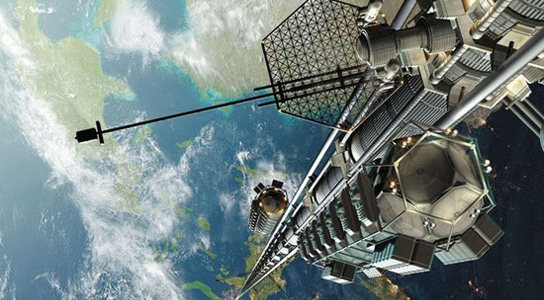
Japanese construction company Obayashi has announced its plan to build a lift to space by 2050. They plan to use carbon nanotubes to create a 96,000 km tether that will connect a base at the equator to a counterweight in orbit. Orbital lifts capable of carrying 30 passengers at a speed of 200 km/h will move along the tether.
Lunar Space Elevator
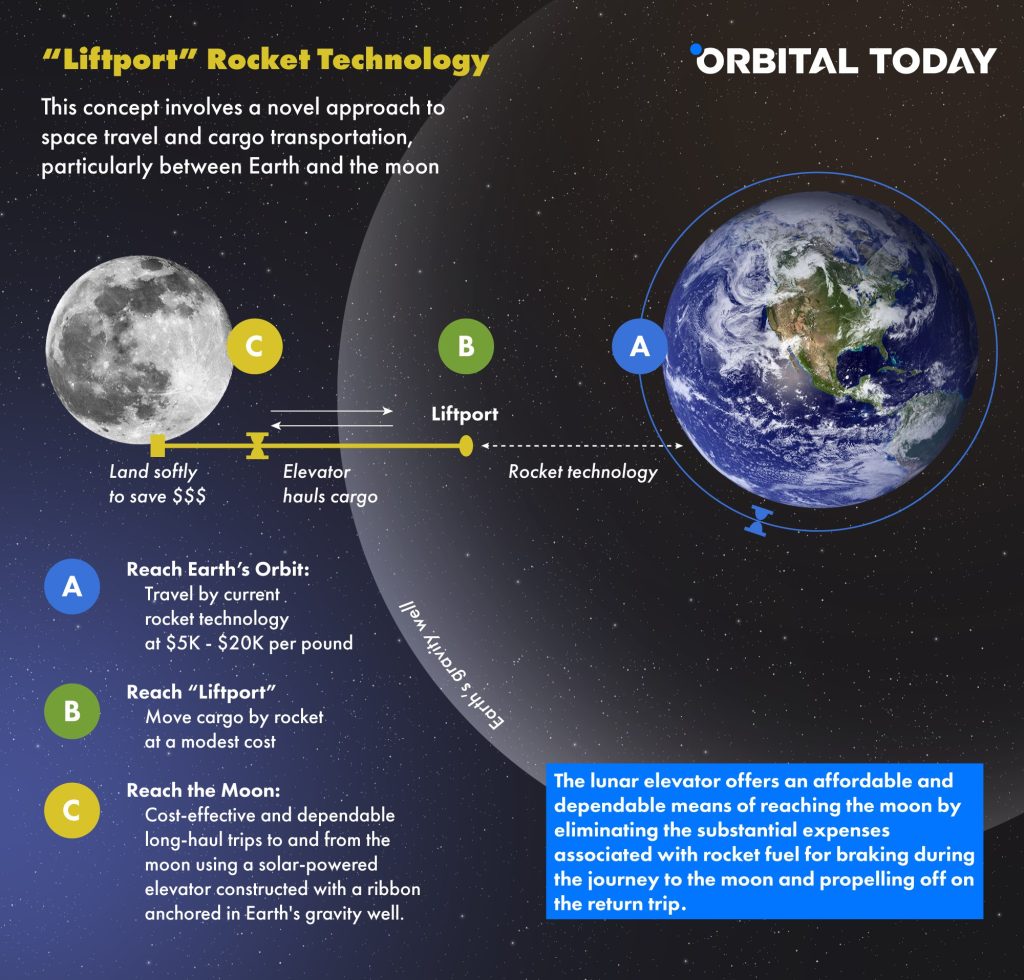
LiftPort company was founded in 2003 by a former NASA employee, Michael Lane, who worked closely on the space lift project with Bradley Edwards. LiftPort is also popularising the use of carbon nanotubes as a tether material. Today, LiftPort offers two concepts: Earth and Lunar, but in light of preparations for the third phase of NASA’s lunar program Artemis, the company is currently focusing on the second concept.
Canadian Space Elevator: Thoth’s Technology Orbital Lift
The Canadian company Thoth Technology received a patent for the orbital lift development in 2015. The concept involves building a tower that retains its rigidity thanks to compressed gas.
The tower should deliver cargo to a height of 20 km, from where they will be launched into orbit using conventional rockets. At the top of the tower, there will be a spacecraft launch pad. According to the company’s calculations, this elevator will save up to 30% of fuel compared to a rocket launch.
Conclusion
Space lift is a promising project that can solve many problems and challenges associated with transportation and exploration. However, like any ambitious, large-scale undertaking, it faces many challenges and risks that must be overcome before this concept becomes a reality. Will we see a time when we can travel into orbit as easily as between floors of a skyscraper? We’ll have to wait and see.
References and Additional Information:
- Analysis of Space Elevator Technology
https://www.colorado.edu/faculty/kantha/sites/default/files/attached-files/25753-58722_-_tyson_sparks_-_may_3_2014_1128_am_-_sparks_final_paper.pdf - Space Elevators and Astronomy. By Andy Darnley
https://www.elevators.com/space-elevators-astronomy/ - The physics of the space elevator/ P. K. Aravind Department of Physics, Worcester Polytechnic Institute, Worcester, Massachusetts https://users.wpi.edu/~paravind/Publications/PKASpace%20Elevators.pdf
- The Modern Day Space Elevator is Closer than You Think!
https://www.isec.org/ - LSEI: Lunar space elevator infrastructure
https://www.liftport.com/ - Japanese company plans space elevator by 2050
https://www.cnet.com/science/japanese-company-plans-space-elevator-by-2050/ - Inflatable ‘space elevator’ invented by scientists https://www.telegraph.co.uk/science/2016/03/15/inflatable-space-elevator-invented-by-scientists/
![Beauty of the Pink Moon And Lyrid Meteor Shower in This Week’s Best Astrophotos [19-26 April] Beauty of the Pink Moon And Lyrid Meteor Shower in This Week’s Best Astrophotos [19-26 April]](https://orbitaltoday.com/wp-content/uploads/2024/04/Pink-Moon-is-on-its-way-above-the-mountains-1-300x300.jpg)





Thank you for your comment! It will be visible on the site after moderation.